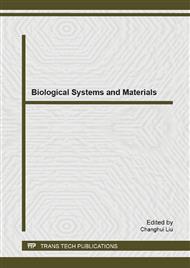p.177
p.182
p.188
p.193
p.199
p.207
p.211
p.214
p.218
Biocompatibility and Degradation of Theophylline/Chitosan Microspheres as Pulmonary Delivery Carriers
Abstract:
The purpose of this study was to investigate the biocompatibility and degradation behavior of theophylline/chitosan microspheres, which has the potential application in pulmonary delivery system. Hemolysis test was carried out to estimate its blood toxicity. In vitro enzymatic hydrolysis was performed in 0.2 mg/ml lysozyme solution, while in vitro hydrolysis degradation was in 0.2 mol/L PBS solution (pH 7.4). The results of hemolysis test showed that the hemolysis rate was 4.771%, which showed that theophylline/chitosan microspheres had no hemolysis. The degradation rate of enzymatic hydrolysis and PBS hydrolysis was 62.66±2.1% and 37.79±1.2%, which indicates that degradation in lysozyme solution is faster than that in PBS solution. The morphology of microspheres with lysozyme and PBS solution developed into rough surfaces and became irregularly shaped. Accordingly, theophylline/chitosan microspheres possess preferable biocompability and degradation, which have promising potential for use as safe carrier in pulmonary drug delivery systems.
Info:
Periodical:
Pages:
199-203
Citation:
Online since:
May 2014
Authors:
Keywords:
Price:
Сopyright:
© 2014 Trans Tech Publications Ltd. All Rights Reserved
Share:
Citation:


